#crown prince george of serbia
Text
List of attendees to the service of Thanksgiving to the late King Constantine of Greece on 27th February 2024.
🇬🇧 Queen Camilla
🇬🇧 Princess Anne
🇬🇧 Sir Tim Laurence
🇬🇧 Princess Beatrice
🇬🇧 Edoardo Mapelli Mozzi
🇬🇧 Zara Tindall
🇬🇧 Mike Tindall
🇬🇧 Lady Sarah Chatto
🇬🇧 Daniel Chatto
🇬🇧 Prince Richard, The Duke of Gloucester
🇬🇧 Birgitte, The Duchess of Gloucester
🇬🇧 Prince Edward, The Duke of Kent
🇬🇧 George, The Earl of St. Andrews
🇬🇧 Sylvana, The Countess of St. Andrews
🇬🇧 Lady Helen Taylor
🇬🇧 Prince Michael of Kent
🇬🇧 Princess Michael of Kent
🇬🇧 Princess Alexandra of Kent
🇬🇧 James Ogilvy
🇬🇧 Julia Ogilvy
🇬🇧 Marina Ogilvy
🇬🇧 George, The Marquess of Milford Haven
🇬🇧 Clare, The Marchioness of Milford Haven
🇬🇧 Penny, The Countess Mountbatten of Burma
🇬🇧 Lady Alexandra Hooper
🇬🇧 Thomas Hooper
🇬🇧 India Hicks
🇬🇧 David Flint Wood
🇬🇧 Amory Wood-Hicks
🇬🇧 Prince Andrew, The Duke of York
🇬🇧 Sarah Ferguson
🇬🇷 Queen Anne-Marie
🇬🇷 Crown Prince Pavlos
🇬🇷 Crown Princess Marie-Chantal
🇬🇷 Prince Achileas-Andreas
🇬🇷 Prince Odysseas-Kimon
🇬🇷 Prince Aristides-Stavros
🇬🇷 Princess Maria-Olympia
🇬🇷 Prince Nikolaos
🇬🇷 Princess Tatiana
🇬🇷 Prince Philippos
🇬🇷 Princess Nina
🇬🇷 Princess Theodora
🇬🇷 Matthew Kumar
🇬🇷 Princess Alexia
🇬🇷 Carlos Morales
🇬🇷 Princess Irene
🇪🇸 King Juan Carlos
🇪🇸 Queen Sofia
🇪🇸 King Felipe
🇪🇸 Queen Letizia
🇪🇸 Infanta Elena
🇪🇸 Infanta Cristina
🇪🇸 Juan Urdangarian
🇩🇰 Princess Benedikte
🇩🇰 Prince Gustav
🇩🇰 Princess Carina of Sayn-Wittgenstein-Berleburg
🇩🇰 Princess Alexandra of Sayn-Wittgenstein-Berleburg, Countess Ahlefeldt-Laurvig-Bille
🇩🇰 Count Michael Ahlefeldt-Laurvig-Bille
🇯🇴 Queen Noor of Jordan
🇯🇴 Prince Hassan
🇯🇴 Princess Sarvath of Jordan
🇧🇬 Prince Kyril of Bulgaria
🇷🇸 Crown Prince Alexander of Serbia
🇷🇸 Crown Princess Katherine of Serbia
🇩🇪 Bernhard, Margrave of Baden
🇩🇪 Stephanie, Margravine of Baden
🇩🇪 Landgrave Donatus of Hesse
🇩🇪 Hereditary Prince Ernst August of Hanover
🇩🇪 Princess Saskia of Hohenlohe-Langeburg
Other notable attendees
Nicholas Soames (Conservative politician)
Rocco Forte (British Hotelier)
Hugh Cavendish, Baron Cavendish of Furness (Former member of the House of Lords)
Grania Mary Caulfield (wife of Baron Cavendish of Furness)
John Kerry (United States Special Presidential Envoy for Climate
Lady Susan Hussey (Lady-in-Waiting)
Sir Jackie Stewart (Racecar Driver and good family friend)
Alexandra von Fürstenberg (American Socialite)
Dax Miller (Alexandra von Fürstenbergs husband)
#i did this for the coronation so i thought i’d do this again#there will be more people who attended so if i missed anyone significant plz dm me#king constantine ii thanksgiving service#british royal family#greek royal family#danish royal family#spanish royal family
13 notes
·
View notes
Note
Fun question. Say if all five survived. Who would YOU see married to the Romanov kids? (Including Saint Alexei, if he survived past the disease he have.)
Hmm, well, Olga wanted to "remain Russian," but being the eldest daughter I think there would still be pressure on her for an equal marriage. Dmitri Pavlovich would be off the table after the Rasputin stuff, obviously. So she might have ended up with perhaps Prince Konstantin Konstantinovich, who apparently fancied her. Another option might be Roman Petrovich. These two are 'only' princes, but they are Romanovs, and she could stay Russian. She'd basically be doing what Xenia did with Sandro, or Olga Alexandrovna's first marriage to Peter of Oldenburg. Also . . . Olga and Vladimir Paley is an interesting idea. He's morganatic so that might be a problem, but he was a thinker and a poet, like her. They could be an interesting match!
Another option was Prince Christopher of Greece; according to Agnes de Stoeckl, who was a lady-in-waiting of Christopher’s sister Maria Georgievna, he once expressed interest in marrying Olga and went so far as to ask Nicholas about it, who gently turned him down saying Olga was too young. But he was about as “Russian” as a foreign prince could be, having been born at Pavlovsk, speaking the language fluently, and his mother Olga Konstantinovna thought he had inherited a ‘Russian soul’ from her.
I'm torn with Tatiana, because on the one hand she's the most devoted to Alix, so she might want to marry someone in Russia so she could remain with Alix, sort of like Helena and Beatrice did with Queen Victoria. But on the other hand . . . she was clearly the most natural born queen among the girls, and her talents might be wasted if she weren't on a throne somewhere. The most lofty would be David, that is the future Edward VIII/Duke of Windsor. Allegedly he preferred her after their meeting at Cowes. But that would require her changing her religion and perhaps even her name (and I don't think he'd make a good husband), so Alexander of Serbia/Yugoslavia or George II of the Hellenes (Greece) might be a better option.
I feel like Maria is the most likely to follow in Olga Alexandrovna's footsteps and marry an officer rather than a prince. I also feel like there would be generally less pressure on the younger daughters to make 'good' matches. I don't think running away with some random soldier she met at the hospital would ever, ever fly, but the officers of the fancy Petersburg regiments were generally well educated and from good, noble and/or military families, and it was pretty clear that Maria had little interest in some grand marriage to a foreign prince. Carol, of course, was a serious contender as her preferred her to Olga, but he was an absolutely terrible husband so I think she'd be much happier with an OA/Kulikovsky type scenario. But I could also see her, like with Olga, marrying a minor relative--after all, most of the Romanov men had military careers, so she could get her ‘soldier’ that way, too!
Anastasia is the biggest mystery to me! I could see her never marrying and remaining the fun, quirky aunt, or surprising everyone by becoming a queen despite being the youngest. The Danish crown prince was about her age, and according to gossip Queen Alexandrine (who had a Romanov mother herself) was hoping for one of the Little Pair for her son. She might fit right in with the fun-loving Danes, and I'm sure Maria Feodorovna would be delighted to see one of her granddaughters marrying back into the Danish family.
With Alexei, I tend to think one of the daughters of Elena Vladimirovna would just make a TON of sense. Ileana is an option too, but she's several years younger than him so he would have to wait for her to grow up. She also didn't really have any experience with Russia at all; in contrast, Olga (1903), Elizabeth (1904) and Marina (1906) spent time in Russia every year up until 1914 visiting their Russian relatives so they would be much more familiar with the culture and customs and know more people than Ileana would. It would also be an almost 'Romeo and Juliet' scenario in that the girls were from the Vladimirovichi branch of the family; Alexei marrying one of them would unite the two rival branches, and maybe the Vladimirs would chill out seeing one of their own married to the Heir.
18 notes
·
View notes
Photo
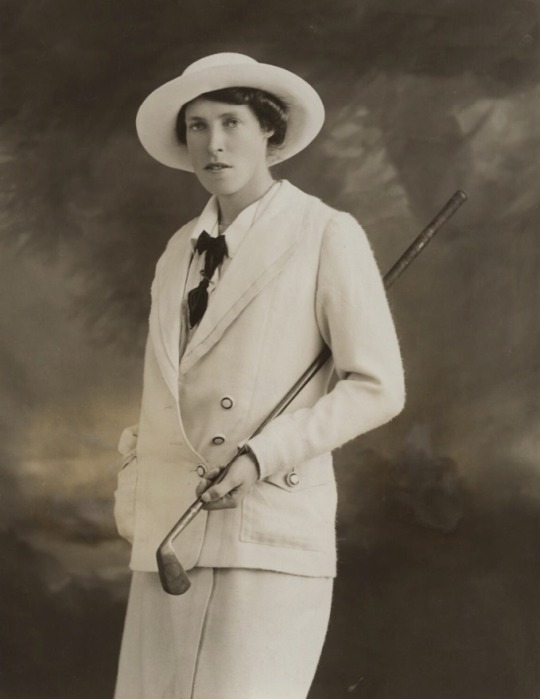
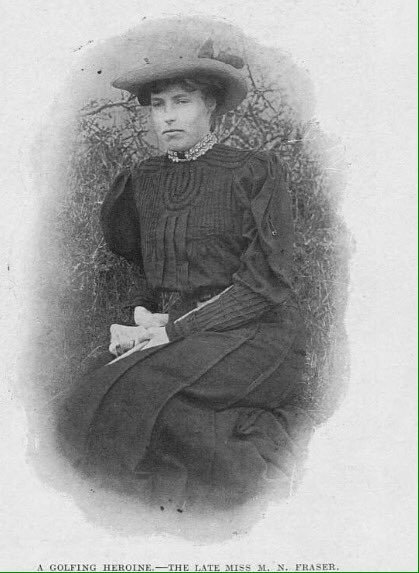
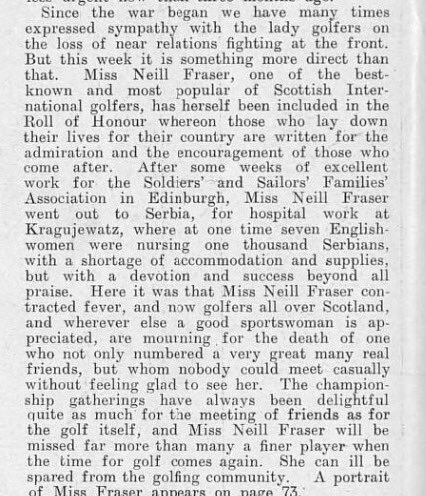
Margaret Neill Fraser was born on 4th June 1880 in Edinburgh.
Madge, as she was known was one of the brave Scottish woment who volunteered for the Scottish Women's Hospital in Serbia under the overall umbrella of the French Red Cross, alongside Elsie Inglis, like Elsie she didn’t survive the war.
Madge was the daughter of Mrs M. Neill Fraser and Patrick Neill Fraser, a botanist. The family lived at Rockville on Murrayfield Road in western Edinburgh and ran the company Neill & Co, who ran a printers and HMO Stationery Office, both at Bellevue and at 13 George Street The printworks was originally started by an uncle and started life at 10 Old Fishmarket Close in the Old Town.
Before the outbreak of World War One Madge was a promising amatuer golfer, her home golf club was Murrayfield Golf Club. She was runner-up in the 1912 Scottish Ladies Golf Championship, beaten by Dorothea Jenkins and semi-finalist in the 1910 British Championship. She played often at internationals in Ranelagh and Barnehurst.Fraser was a member of the Golfing Gentlewomen and the Ladies' Golf Union. She represented Scotland at international level every year from 1905 to 1914.
Fraser was a member of the St Andrews Ambulance Association and a trained nurse. At the outbreak of the First World War she volunteered alongside others for the Scottish Women's Hospital in Serbia. The majority of the group of women were also suffragettes, for example women doctors surveyed in 1908 had been 538 for the vote and only 15 against. At the time high profile women golfers, like Fraser were a rarity even being allowed to play on men's courses and wanted to demonstrate responsibility and fair play, thus 'most good women golfers of that time tolerated the Suffragists and abhorred the Suffragettes'.
Fraser arrived at the hospital in Kragujevac in Serbia in December 1914 in the midst of a typhus epidemic, tragically she contracted typhusand died on 8th March 1915. Twenty-one other Scottish medical workers died in the same epidemic. Fraser is buried in the Niš Commonwealth Military Cemetery, eastern Serbia and is remembered on her parents’ grave stone in Dean Cemetery in Edinburgh.
It was a double tragedy for the family, her brother, Patrick Neill Fraser, was a Lieutenant in the Border Regiment and was killed on 1 July 1916, the first day of the Battle of the Somme.
Following Fraser's death, she was described as 'perhaps the most popular woman's golfer in Great Britain' he Ladies Golf Union collected funds from international donors sufficient to provide 200 additional beds in Serbian hospitals in her memory. And it was reported that a transport lorry for Elsie Inglis' latest field hospital, was funded by her golfing friends, and seen leading out a column of vehicles by the Serbian Crown Prince George.Fraser's funeral was described as a 'terribly sad affair with the funeral party having to struggle through thick snow and mud. Margaret Neill Fraser is also commemorated on the Scottish Women's Hospitals' Roll of Honour;
"There is no Sea
Nor Time nor Space nor Division
In
God's dear Home
There is only God and His strong
Love and Peace
and
A GREAT REMEMBERING."
" Let us remember before God these women
Who gave their lives in the service of others."
Madge Neill Fraser is the only woman listed on Murrayfield Golf Club's Roll of Honour. The British Journal of Nursing expressed regret at her death, and noted she was a nurse and a chauffeur.
14 notes
·
View notes
Text
Events 9.8 (before 1900)
617 – Battle of Huoyi: Li Yuan defeats a Sui dynasty army, opening the path to his capture of the imperial capital Chang'an and the eventual establishment of the Tang dynasty.
1100 – Election of Antipope Theodoric.
1198 – Philip of Swabia, Prince of Hohenstaufen, is crowned King of Germany (King of the Romans)
1253 – Pope Innocent IV canonises Stanislaus of Szczepanów, killed by King Bolesław II.
1264 – The Statute of Kalisz, guaranteeing Jews safety and personal liberties and giving battei din jurisdiction over Jewish matters, is promulgated by Bolesław the Pious, Duke of Greater Poland.
1276 – Pope John XXI is elected Pope.
1331 – Stefan Dušan declares himself king of Serbia.
1380 – Battle of Kulikovo: Russian forces defeat a mixed army of Tatars and Mongols, stopping their advance.
1504 – Michelangelo's David is unveiled in Piazza della Signoria in Florence.
1514 – Battle of Orsha: In one of the biggest battles of the century, Lithuanians and Poles defeat the Russian army.
1522 – Magellan–Elcano circumnavigation: Victoria arrives at Seville, technically completing the first circumnavigation.
1565 – St. Augustine, Florida is founded by Spanish admiral and Florida's first governor, Pedro Menéndez de Avilés.
1655 – Warsaw falls without resistance to a small force under the command of Charles X Gustav of Sweden during The Deluge, making it the first time the city is captured by a foreign army.
1727 – A barn fire during a puppet show in the village of Burwell in Cambridgeshire, England kills 78 people, many of whom are children.
1755 – French and Indian War: Battle of Lake George.
1756 – French and Indian War: Kittanning Expedition.
1760 – French and Indian War: French surrender Montreal to the British, completing the latter's conquest of New France.
1761 – Marriage of King George III of the United Kingdom to Duchess Charlotte of Mecklenburg-Strelitz.
1775 – The unsuccessful Rising of the Priests in Malta.
1781 – American Revolutionary War: The Battle of Eutaw Springs in South Carolina, the war's last significant battle in the Southern theater, ends in a narrow British tactical victory.
1793 – French Revolutionary Wars: Battle of Hondschoote.
1796 – French Revolutionary Wars: Battle of Bassano: French forces defeat Austrian troops at Bassano del Grappa.
1810 – The Tonquin sets sail from New York Harbor with 33 employees of John Jacob Astor's newly created Pacific Fur Company on board.
1813 – At the final stage of the Peninsular War, British-Portuguese troops capture the town of Donostia (now San Sebastián), resulting in a rampage and eventual destruction of the town.
1831 – William IV and Adelaide of Saxe-Meiningen are crowned King and Queen of the United Kingdom of Great Britain and Ireland.
1831 – November uprising: The Battle of Warsaw effectively ends the Polish insurrection.
1855 – Crimean War: The French assault the tower of Malakoff, leading to the capture of Sevastopol.
1860 – The steamship PS Lady Elgin sinks on Lake Michigan, with the loss of around 300 lives.
1862 – Millennium of Russia monument is unveiled in Novgorod.
1863 – American Civil War: In the Second Battle of Sabine Pass, a small Confederate force thwarts a Union invasion of Texas.
1883 – The Northern Pacific Railway (reporting mark NP) was completed in a ceremony at Gold Creek, Montana. Former president Ulysses S. Grant drove in the final "golden spike" in an event attended by rail and political luminaries.
1888 – Isaac Peral's submarine is first tested.
1888 – The Great Herding (Spanish: El Gran Arreo) begins with thousands of sheep being herded from the Argentine outpost of Fortín Conesa to Santa Cruz near the Strait of Magellan.
1888 – In London, the body of Jack the Ripper's second murder victim, Annie Chapman, is found.
1888 – In England, the first six Football League matches are played.
1892 – The Pledge of Allegiance is first recited.
1898 – Seven hundred Greek civilians, 17 British guards and the British Consul of Crete are killed by a Turkish mob.
0 notes
Text

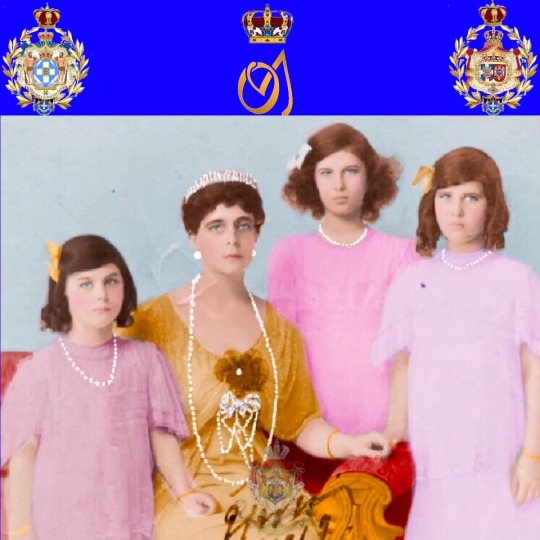
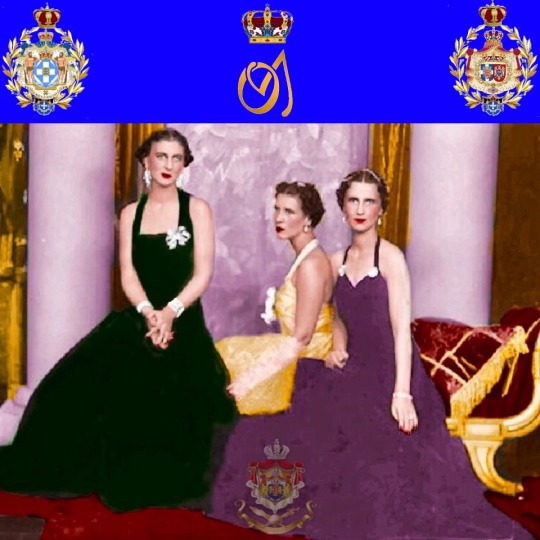

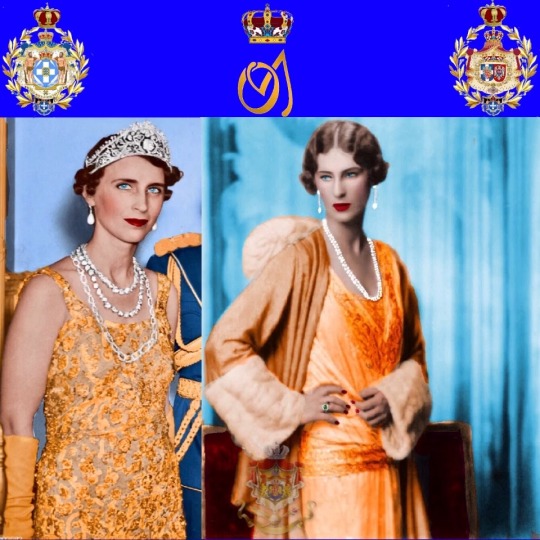





Yesterday was 120 years since the birth of HRH Princess Olga of Greece and Denmark and Yugoslavia (11 June 1903 )
She was a Greek princess who married Prince Paul, Regent of the Kingdom of Yugoslavia. After her marriage, she was known as Princess Paul of Yugoslavia.
Princess Olga was a daughter of Prince Nicholas of Greece and Denmark and Grand Duchess Elena Vladimirovna of Russia, and a granddaughter of King George I of Greece. After a brief engagement in 1922 to Crown Prince Frederick of Denmark, she married Prince Paul of Yugoslavia in 1923. In 1934, after the assassination of King Alexander I, Prince Paul was appointed regent of Yugoslavia on behalf of King Peter II, and Princess Olga became the senior lady of the court and acted as first lady of Yugoslavia, working side by side with her husband on representation duties. In 1941, during the Second World War, Prince Paul was forcibly removed from power after signing the Tripartite Pact, which took Yugoslavia into the Axis with Germany and Italy. Paul, Olga, and their three children were arrested and given as prisoners to the British. They spent the rest of the war in house arrest and exile in Egypt, Kenya and South Africa, and were not allowed to return to Europe until 1948. The couple and their children eventually settled in Paris, where Paul died in 1976. Having become a widow, Olga spent more and more time in the United Kingdom, the adopted country of her sister, Marina. Struck by Alzheimer's disease at the end of her life, Olga died in Paris in 1997. Her remains were buried at the Bois-de-Vaux Cemetery, Lausanne, Switzerland, before being transferred to the royal mausoleum of Oplenac, in Serbia, in 2012
Χθες συμπληρώθηκαν 120 χρόνια από τη γέννηση της ABY Πριγκίπισσας Όλγας της Ελλάδας Δανίας και της Γιουγκοσλαβίας (11 Ιουνίου 1903)
Ήταν μια Ελληνίδα πριγκίπισσα που παντρεύτηκε τον Πρίγκιπα Παύλο, Αντιβασιλέα του Βασιλείου της Γιουγκοσλαβίας. Μετά το γάμο της, ήταν γνωστή ως πριγκίπισσα Παύλου της Γιουγκοσλαβίας.
Η πριγκίπισσα Όλγα ήταν κόρη του πρίγκιπα Νικολάου της Ελλάδας και της Δανίας και της Μεγάλης Δούκισσας Έλενας Βλαντιμίροβνα της Ρωσίας και εγγονή του Βασιλιά Γεωργίου Α' της Ελλάδας. Μετά από έναν σύντομο αρραβώνα το 1922 με τον διάδοχο του θρόνου Φρειδερίκο της Δανίας, παντρεύτηκε τον πρίγκιπα Παύλο της Γιουγκοσλαβίας το 1923. Το 1934, μετά τη δολοφονία του βασιλιά Αλέξανδρου Α', ο πρίγκιπας Παύλος διορίστηκε αντιβασιλέας της Γιουγκοσλαβίας για λογαριασμό του βασιλιά Πέτρου Β' και η Πριγκίπισσα Όλγα έγινε η ανώτερη κυρία του δικαστηρίου και ενήργησε ως πρώτη κυρία της Γιουγκοσλαβίας, δουλεύοντας δίπλα-δίπλα με τον σύζυγό της σε καθήκοντα εκπροσώπησης. Το 1941, κατά τη διάρκεια του Β' Παγκοσμίου Πολέμου, ο πρίγκιπας Παύλος απομακρύνθηκε βίαια από την εξουσία μετά την υπογραφή του Τριμερούς Συμφώνου, το οποίο έφερε τη Γιουγκοσλαβία στον Άξονα με τη Γερμανία και την Ιταλία. Ο Παύλος, η Όλγα και τα τρία τους παιδιά συνελήφθησαν και δόθηκαν αιχμάλωτοι στους Βρετανούς. Πέρασαν το υπόλοιπο του πολέμου σε κατ' οίκον περιορισμό και εξορία στην Αίγυπτο, την Κένυα και τη Νότια Αφρική και δεν τους επετράπη να επιστρέψουν στην Ευρώπη μέχρι το 1948. Το ζευγάρι και τα παιδιά τους τελικά εγκαταστάθηκαν στο Παρίσι, όπου ο Παυλος πέθανε το 1976. Έχοντας γίνει χήρα, η Όλγα περνούσε όλο και περισσότερο χρόνο στο Ηνωμένο Βασίλειο, την υιοθετημένη χώρα της αδερφής της, Μαρίνας. Χτυπημένη από τη νόσο του Αλτσχάιμερ στο τέλος της ζωής της, η Όλγα πέθανε στο Παρίσι το 1997. Τα λείψανά της θάφτηκαν στο νεκροταφείο Bois-de-Vaux, στη Λωζάνη, στην Ελβετία, πριν μεταφερθούν στο βασιλικό μαυσωλείο του Oplenac, στη Σερβία, το 2012
#kingconstantine#danishroyalfamily#crownprincepavlos#queenannemarie#greek royal family#house of romanov#crownprincessmariechantal#greekroyals#princeconstantinealexios#danishroyals
1 note
·
View note
Text
Lady Gabriella Windsor has taken her first steps into public life in the shoes of her cousin Prince William. She will stand at the funeral of the former King of Greece.
Accompanied by Princess Royal, Lady Gabriella, 41, daughter of Prince Michael of Kent, was asked to represent the future king at the Metropolitan Cathedral in Athens.
It comes after King Charles hinted that Prince Andrew, recently embroiled in a legal battle, and Harry, whose book Spare shook the royal family, would be sidelined indefinitely as working royals.
The King recently extended his list of counsellors of state who can deputize for the monarch if he is overseas on an official trip or ill.
Lady Gabriella married financier Thomas Kingston in 2019. The intimate ceremony in St. George’s Chapel at Windsor Castle was attended by several senior members of the royal family, including Queen Elizabeth II and Prince Harry.
Her godfather Constantine II, a second cousin to King Charles III, died aged 82 at a private hospital in Athens on 10 January.
The former and last king of Greece, whose first cousin was Prince Philip, was close to Charles, earning him the title of godparent to William.
His close tie to the British royal family was later affirmed, as the Prince of Wales agreed to be named godfather to Constantine’s first grandson, Constantine Alexios.
Guests at Constantine’s funeral were royals from Denmark, Norway, Sweden, the Netherlands, Belgium, Luxembourg, Serbia and Monaco.
Notable attendees included Queen Margrethe of Denmark, King Felipe and Queen Letizia of Spain. Prince Philippos of Greece and Denmark and Pavlos, Crown Prince of Greece, both attended their father’s funeral.
Monday’s service, officiated by the country’s archbishop, Ieronymos, was private, reflecting Constantine’s status as a former king.
When he acceded to the throne as Constantine II at 23 in 1964, the youthful monarch, who had already achieved glory as an Olympic gold medalist in sailing, was hugely popular.
By the following year, he had squandered much of that support with his active involvement in the machinations that brought down the popularly elected Center Union government of prime minister George Papandreou.
The episode, still widely known in Greece as the “apostasy,” or defection from the ruling party of several lawmakers, destabilized the constitutional order and led in 1967 to a military coup. Constantine eventually clashed with the military rulers and was forced into exile.
In his final years, while accepting that Greece was now a republic, he continued to style himself as King of Greece and his children as princes and princesses. This was even though Greece no longer recognized titles of nobility.
He lived in Hampstead Garden Suburb, London.
0 notes
Text

January 06
[1017] Cnut the Great crowned King of England in London by Lyfing, Archbishop of Canterbury.
[1066] Following the death of Edward the Confessor, his brother-in-law Harold Godwineson, head of the most powerful noble family in England, is crowned King Harold II.
[1099] Henry V crowned German King.
[1205] Philip of Swabia becomes King of the Romans.
[1322] Stephen Uros III becomes King of Serbia.
[1352] French King Jean II introduces Order of the Star.
[1355] Charles I of Bohemia is crowned with the Iron Crown of Lombardy.
[1449] Byzantine Emperor Constantine XI is crowned at Mistra.
[1453] Emperor Frederik III becomes archduke of Austria.
[1540] King Henry VIII of England weds his fourth wife, Anne of Cleves.
[1649] The English Rump Parliament votes to put King Charles I on trial for treason and other "high crimes".
[1690] Joseph I, later Holy Roman Emperor and son of Emperor Leopold I, becomes King of the Romans.
[1745] Bonnie Prince Charlies' army draws to Glasgow.
[1759] US 1st President George Washington weds Martha Dandridge Custis at White House Plantation.
[1809] Napoleonic Wars: Invasion of Cayenne, by combined British, Portuguese and colonial Brazilian forces, begins.
[1838] Samuel Morse unveils the telegraph, revolutionizing communication.
[1903] Theoretical Physicist Albert Einstein (23) weds Mileva Maric.
[1912] New Mexico is admitted into the United States as the 47th state.
[1929] Alexander I establishes a royal dictatorship in Yugoslavia.
[1945] Future 41st President George H. W. Bush (20) weds Barbara Pierce (19) at the First Presbyterian Church in Rye, New York.
[1950] Great Britain announced its recognition of the People's Republic of China.
[1996] Snow begins falling in Washington D.C., and up the Eastern seaboard, beginning a blizzard that kills 154 people and causes over $1 billion in damages before it ends.
[2016] "Star Wars: The Force Awakens" breaks North American box office record, passing the $760.5M taken by "Avatar".
[2019] Malaysian king Sultan Muhammad V abdicates after two years of rule in historical first.
[2021] A mob of President Donald Trump supporters descend on the U.S. Capitol, attempting to interfere with the certification of electoral votes from the 2020 presidential election.
#on this day in history#on this day#otdih#otd#american history#world history#january#january 06#samuel morse#donald trump#edward the confessor#harold godwineson#king charles i#cnut the great#philip of swabia#stephen uros iii#order of the star#constantine xi#bonnie prince charlie#napoleonic wars#star wars#star wars the force awakens#george washington#martha dandridge custis#albert einstein#george h. w. bush#king henry viii#anne of cleves
0 notes
Text
1920S Royal Musings
Topping the list of eligible young males, at least on paper, was the Prince of Wales, Edward, known to family and friends as David. Born in June 1894, David was considered to be the greatest catch, as he was the future king of the United Kingdom of Great Britain and Ireland. Cunliffe-Owen pointed out that "it is quite probable that the people of England would voice, through Parliament, their disapproval, of any scheme for marrying one of the sons of King George to a Princess of one of the former sovereign houses of Germany. But no objection would be raised if the young scion of the British reigning house should follow the advice of his heart and wed one of his father's subjects, or even an American girl of the Protestant faith." One presumes, however, that the American girl could not be twice divorced, with both husbands still living.
Among the princesses rumored to be engaged to the Prince of Wales was Princess Ingrid of Sweden, whose late mother was Princess Margaret of Connaught, a granddaughter of Queen Victoria, who was presented to Queen Mary in 1928, restoring "a bond broken by war." During the first world war, King George and Queen Mary would not receive members of neutral countries. Sweden, a neutral nation, had welcomed, much to the disappointment of the British sovereigns, the German Empress Auguste Victoria. "A coolness ensued" between Sweden and Britain, but "the old friendship was restored when Princess Ingrid bowed her head before King George and Queen Mary."
Princess Ingrid was also the guest of honor at a ball at the Swedish Embassy, but the Prince of Wales did not attend. The rumors, however, continued when Ingrid returned to England less than a year later. "Surely, such a speedy repetition must have some significance, say those who always try to explain everything," Virginia Pope wrote. "But Ingrid is the granddaughter of the Duke of Connaught, and what is more natural than that she should show some interest in him."
Prince Leopold, Duke of Brabant, heir to the Belgian throne, was also unmarried, as were the heirs to the thrones of Italy, Spain, Norway, and Denmark. King Boris III of Bulgaria was in search of a queen, although, he was "arousing the fears of conservative monarchists by threatening to seek a mere dollar princess to share the Bulgarian throne."
Published on October 7, 1923, Cunliffe-Owen's article, "Princes Are Few for Royal Maids," profiled several European princesses, including Princess Mafalda of Italy, Princess Marie-José of Belgium, and Princess Olga of Greece. This article was published a fortnight before Olga's marriage to Prince Paul of Serbia. "The engagement of Prince Paul of Serbia and Princess Olga of Greece has revived the discussion of the difficulties that confront the persons of Europe who seek mates. Princess Olga is accounted a lucky girl. Impoverished by recent political events in Greece, she is to marry great wealth. Better yet, she is in love with Paul and he with her. But best of all -- and this is what the matchmaking mothers of Court Society have most in mind - she is to marry a man of her own station in life."
Cunliffe-Owen said that "the good fortune of finding a mate of equal rank cannot fail to a lot of all the marriageable Princesses of Europe nowadays. There are a fairly large number of such women, and if they resolve to wed none but Princes of the blood royal many of them will have to remain single. Royal society is not what it was before 1914. Half of Europe is not speaking to the other half and the list of Princes that any Princess may consider is lamentably short.
"The war has left so many painful memories that generations will pass before there can be matrimonial alliances between members of dethroned dynasties and sovereign houses of the Entente. German and Austrian Princes and Princesses realize that they owe the loss of their crowns and their fortunes to the victorious powers in the international conflagration. Nor can the scions of their foes forget the enmity of Germany and of Austria-Hungary."
Early in the decade, four of the most important weddings took place in the Balkans. Queen Marie of Roumania, a granddaughter of Queen Victoria, and by birth a British princess, was one of the most indefatigable matchmakers of the period. In 1921, she managed to marry off two of her children, Crown Prince Carol and Princess Elisabeth, to the eldest children of her first cousin, Queen Sophie of the Hellenes. Elisabeth was the first to marry, in February 1921, King George II of the Hellenes. One month later, Carol married George's sister, Princess Helen. Queen Marie scored another Balkan success a year later when she arranged the marriage of her daughter, Marie, to King Alexander I of Serbia.
None of the marriages was successful. Carol and Helen's marriage ended in divorce in 1928; seven years later, Elisabeth and George were also divorced. In 1934, Marie was widowed when her husband was assassinated while on a state visit to Marseilles.
The year before Princess Olga married Prince Paul, she had accepted the proposal of Crown Prince Frederik of Denmark. This engagement, engineered by their mothers, ended after only a few months. It was said that the Crown Prince's drinking problem was the main reason why "dignified and stately" Olga ended the relationship.
Although Queen Mary had considered Olga as a possible wife for the Prince of Wales, and arrangements were made for the Greek princess to meet the heir to the throne. At a ball hosted by Princess Nicholas' cousin, Lady Zia Wernher, Olga made an impression, not on the Prince of Wales, but on Prince Paul of Yugoslavia. A first cousin of King Alexander I, Paul was handsome, Oxford-educated, and an art enthusiast. He was also good friends with the Duke and Duchess of York.
Paul pursued Olga throughout the summer, and she accepted his proposal during a visit to the cinema in July 1923. The Duke of York served as the best man; and the day before the wedding, he also acted as one of the godparents to the infant Crown Prince Peter of Yugoslavia, the first child of King Alexander and Queen Marie.
Three months earlier, Princess Jolanda of Italy married Count Giorgio Calvi di Bergolo. Although her parents had accepted Jolanda's choice of a husband -- it was unusual for an Italian princess to marry outside the royal caste --her younger sisters were expected to make far grander marriages. It had been suggested that when the King and Queen of the Belgians had made a state visit to Italy, Jolanda would become engaged to their elder son, Prince Leopold. "But the stay of the royal party at Rome was brought to a close without the announcement."
The two royal families were determined to arrange a marriage between their children; and not long before Jolanda's marriage, rumors about Mafalda's future marriage began to circulate throughout Europe. Mafalda, only 20, was going to marry -- surprise! -- Crown Prince Leopold of the Belgians; and their engagement, according to a report in The New York Times would be "announced immediately after the marriage of Princess Jolanda, according to a report current in court circles here."
The day after Jolanda's wedding, the Associated Press published a report by the Agenzia D'Italia, that Mafalda's betrothal to the Duke of Brabant "will be announced shortly." Even though no announcement was made at the predicted time, rumors of an Italian-Belgian engagement persisted through the summer of 1923. "Such an alliance would have united two Catholic families, war-time allies, and politically, it was said, would have strengthened the position of each dynasty." Not only was Mafalda expected to marry the heir to the Belgian throne, her younger brother, Crown Prince Umberto, was being linked with Leopold's sister, Marie-José. That September, the situation reached an apex when the King and Queen of the Belgians joined the Italian royal family at their summer home at Racconigi. An announcement about the two engagements was expected to be made on September 15, Umberto's 19th birthday. But just a day earlier, Mafalda and her younger sister, Giovanna, were both stricken with typhoid fever. Umberto was quickly sent on a cruise to avoid contagion, and the Belgian royal family hurried back to Brussels. The two young princesses were eventually restored to health, but the marriages were put on hold.
Princess Mafalda was, however, in love, not with the Belgian Crown Prince, but with another man, an art student she had met at the villa of a well-known painter. She confided her secret to Giovanna, who said: "I would rather die and would die if I were forced to marry somebody I did not love. You do not love Leopold. Why should you marry him? I would not."
British writer F. Cunliffe-Owen wrote: "superstitious people in Italy have come to the conclusion that no matrimonial alliance between their reigning family and the royal house of Belgium will ever take place, and that since Providence has manifestly some other projects for the children of their King and Queen, it would be unwise to run counter to the decrees of Heaven, where all really successful marriages are made."
The Italian princess would also be linked with the Prince of Wales when she and her parents visited London in 1924. According to The New York Times, "the British heir on that occasion accompanied her in public and was said to have been very attentive to her."
The Prince of Wales was probably just being nice to Mafalda. Unless the Italian princess was willing to relinquish her Catholic faith, the prince would not be able to marry her. As far back as 1920, Prime Minister Lloyd George had told the king that "the country would not tolerate the Prince marrying a foreign princess."
Although the king and queen would support marriage with a British aristocrat, Queen Mary would have preferred a royal princess as her eldest son's consort.
Lloyd George, concerned enough about a possible marriage with the Italian princess, sought out the views of prominent British Roman Catholics. If the Princess renounced her religion, he was told that there would be no Roman Catholics at the British court. But if she were to marry the Prince of Wales, the princess would have to convert. During a visit to Tokyo, David settled the question of this marriage when he made it clear to British Embassy personnel that he was not going to marry Princess Mafalda.The American media was largely responsible for repeating the various rumors of alleged engagements and marriages. Indeed, during the late 1920s, the Prince of Wales was "married off to at least nine continental princesses, least probably Princess Eudoxia of Bulgaria, thirty-nine years old, hefty and a musician."
The Prince of Wales was, however, happily attached to a married woman, Freda Dudley Ward, and was showing no inclination to marry.The art student who had won Mafalda's heart was Prince Philipp of Hesse, the eldest son of the Landgrave Friedrich Karl of Hesse and Princess Margarete of Prussia. He was also very rich; he was heir to several castles, and he was Protestant and German. Although they would have preferred marriage with the Catholic Leopold of Belgium, Mafalda's parents were not opposed to her marrying Prince Philipp. But Mafalda was told she would have to wait two years before a marriage could take place, as the political and religious hurdles had to be overcome. The couple was married on September 23, 1925. "Mafalda and Philip Wed in Royal Pomp; Gay Crowds Cheer," blared the headline on the front page of The New York Times. During the summer, special ecclesiastical arrangements had been made for the marriage. Mafalda would remain Roman Catholic, and "the ceremony [will be] accompanied by all the Catholic religious rites, except a special mass, for which no special dispensation can be made."
Not long after Mafalda's wedding, Princess Giovanna became the subject of the media's attention. And, once again, the talk turned to a Belgian marriage. The New York Times reported that "it was later stated, but not confirmed, that Giovanna was the one selected for the Belgian Crown Prince."
Crown Prince Leopold had other ideas about his future queen. The 24-year-old Prince's engagement to Princess Astrid of Sweden, 20, was announced in September 1926. His father, King Albert I, said in an interview, "The Queen and myself expect the marriage to be a happy event for both dynasties and peoples. The Princess will soon feel fully at home in Belgium. Their marriage is entirely one of inclination. The Prince and Princess met several times before her visit last month to Clergnon Castle. They are acting in complete liberty and independence without interference from anybody." Leopold turned 25 the day before the civil ceremony in Sweden, which took place on November 4th. A week later, Leopold and Astrid were married in a Roman Catholic ceremony in Brussels. As Astrid was Lutheran, a special ecclesiastical dispensation was granted to permit the marriage in a Roman Catholic Church. The ceremony was Catholic but without the nuptial mass.
"All Belgium has given its heart to the young Princess, whose destiny but a few months ago appeared far removed from her entrance into one of the reigning royal houses of Europe. The fact that the marriage was one of love, and not for political reasons, had struck a responsive note in the hearts of the people and their enthusiasm could not be restrained." More than 200,000 Belgians lined the streets to catch a glimpse of the new Duchess of Brabant.
Not long afterward, the papers were reporting yet another engagement, this time between Leopold's sister, Marie-José, and Crown Prince Olav of Norway. "Court officials deny that marriage is contemplated between the son of King Haakon and King Albert's daughter, but they denied that Prince Leopold and Princess Astrid were to be married until a few weeks ago. Therefore aristocratic circles are confident that they will get invitations to a second wedding next spring."
But an Italian-Norwegian wedding was unlikely. In March 1929, Crown Prince Olav married his first cousin, Princess Martha of Sweden, two years his senior, in a Lutheran ceremony in Oslo. The guests included the Duke and Duchess of York, as the Duke was the Crown Prince's best man. The groom's mother, Queen Maud, came into the church "wearing a cloak of silver tissue with a tiara of diamonds gleaming from her hair." Meanwhile, back in Rome, the Italian court was still considering Marie-José as a bride for Crown Prince Umberto. The New York Times described this possible match as "uncertain," and complicated "by the outspoken admiration of Umberto for the daughters of the Duke of Guise, the French pretender, who attended Mafalda's wedding with bobbed hair and short skirts, their modernity in thought and manner appearing complete, not excessive."
1 note
·
View note
Text
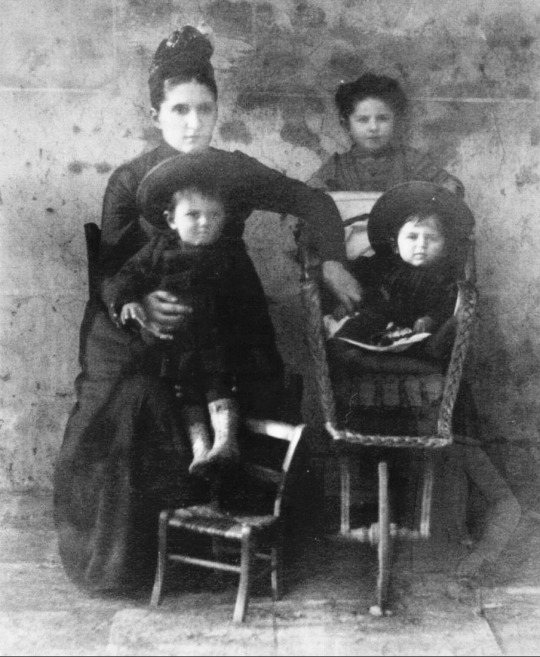
Rare photo
Princess Zorka of Serbia with her children, Princess Helen, Crown Prince George and Prince Alexander (future King of Yugoslavia), 1889.
#princess zorka of montenegro#Ljubica Petrović-Njegoš#princess helen of serbia#crown prince george of serbia#king alexander i of yugoslavia#prince alexander of serbia#serbian royal family#yugoslavian royal family#1889#1880s#princess zorka of serbia
55 notes
·
View notes
Text

Grand Duchess Olga Nikolaevna Romanova of Russia at Tsarskoe Selo in 1913.
At the time of this photo she was 18,Olga died at aged 23. During that era ~ whether it was arranged or for love,females married young.If she did she could have escaped the horror that was to come.Her own mother,the Empress Alexandra Feodorovna of Russia was considered old at aged 22 when she married.
Her marriage prospects
•Prince Ioann Konstantinovich Romanov of Russia fell in love with Olga. When he was 16, he attended Alexei's christening in 1904 and met the 9-year-old Olga. He reflected that “I was so enraptured by her I can’t even describe it. It was like a wildfire fanned by the wind. Her hair was waving, her eyes were sparkling, well, I can’t even begin to describe it!!”. In 1908, he traveled to the Crimea "only out of hunger to see Olga." He admitted his feelings to Olga's parents, but they rejected him. He told his father, "They won't let me marry Olga Nikolaevna."
•In 1911, there were rumors that Olga would marry George, Crown Prince of Serbia or Prince Boris of Bulgaria.The article claimed that Nicholas intended to make his four daughters the "Queens of the Balkans" to keep the Balkan states faithful to Russia.
•After the Coronation of King George V of the United Kingdom there was speculation that either Olga or Tatiana would marry Prince Edward of Wales.
•There were rumors that Olga and her first cousin once removed Grand Duke Dmitri Pavlovich Romanov of Russia were romantically involved. As an orphan, Dmitri was very close to Olga's parents, which provoked more speculation that he would marry Olga. Arthur Cherep-Spiridovich wrote, “Such was the Emperor’s affection for him that all the entourage already saw in him the future fiancé of one of the grand duchesses.Alexandra Bogdanova, the wife of a general and hostess of a monarchist salon, wrote in her diary on 7 June 1912 that Olga had been betrothed the previous night to Grand Duke.The Washington Post reported that Olga had refused Prince Adalbert because "she had given her heart to her cousin Grand Duke Dmitri Paulovitch."In August 1912, Meriel Buchanan, the British ambassador's daughter, wrote in her diary, "I heard a rumour yesterday that a certain person is going to marry the Emperor’s eldest daughter. I can’t quite believe it considering all the high and mighty people who are panting to marry her. Of course she may have a coup de foudre for him and insist on having her own way.” In his book The Rasputin File, Edvard Radzinsky speculates that the betrothal was broken off due to Dmitri's dislike for Grigori Rasputin, his association with Felix Yussupov and rumors that Dmitri was bisexual.However, no other sources mention an official betrothal to Dmitri Pavlovich.
•Before World War I, there was some discussion of a marriage between Olga and Prince Carol of Romania. In 1914, Foreign Minister Sergey Sazonov advocated the match because he wanted to ensure that the Romanian royal family would support Russia in case of a future conflict. Nicholas and Alexandra saw the benefits of the match, but they insisted that “the grand duchess’s marriage … should take place only as the result of a much closer acquaintance between the young people and on the absolute condition of their daughter’s voluntary agreement to it."In March 1914, Crown Prince Ferdinand of Romania, Crown Princess Marie of Romania, and Prince Carol of Romania visited the Romanovs in St. Petersburg. Despite going on walks and dinners with each other, Olga and Carol seemed uninterested in each other. During a visit to Romania in the spring of 1914, Olga and Carol were uninterested in each other and did not speak to each other. Crown Princess Marie of Romania, noted that Carol was "not enamored of Olga's broad, plain face and brusque manner." She judged that Olga's face "was too broad, her cheekbones too high," and she told her mother that all of the grand duchesses "were not found very pretty." Marthe Bibesco, who was with the Romanian party, heard a rumor that the grand duchesses had "decided... to make themselves as ugly as they could.... so that Carol should not fall in love with any of them.". The plans were, in any event, put on hold upon the outbreak of war in 1914.
•Olga told Pierre Gilliard that she wanted to marry a Russian and remain in her own country. She said her parents would not force her to marry anyone she could not like.
•In 1913, Duchess Marie of Mecklenburg-Schwerin asked Alexandra about a potential marriage between the 18-year-old Olga and her own 38-year-old son, Grand Duke Boris Vladimirovich of Russia. Alexandra was horrified, because "the idea of Boris is too unsympathetic." She refused to allow "a pure, fresh girl" to marry "a well-used, half worn out, blasé young man" and "live in a house in which many a woman has shared his life."
13 notes
·
View notes
Text
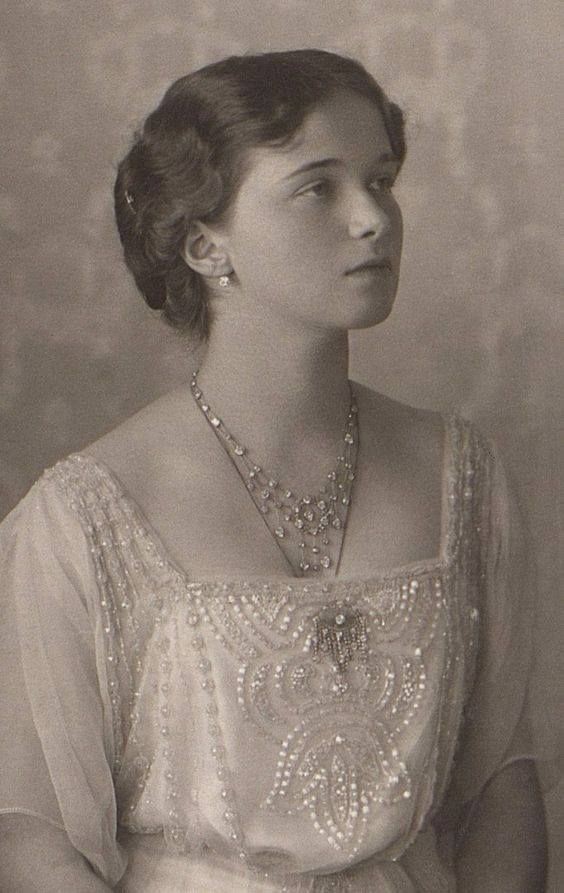
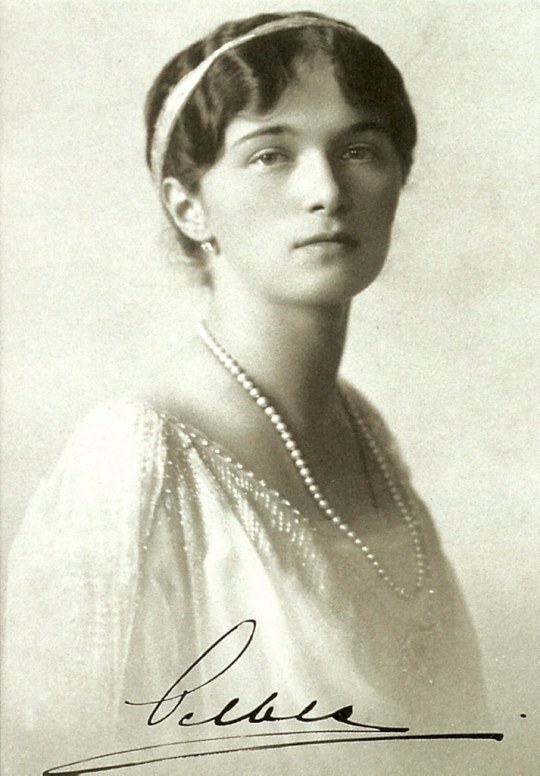


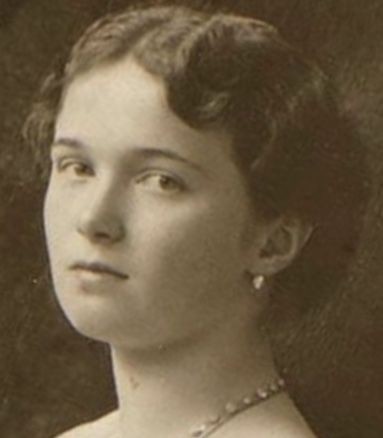


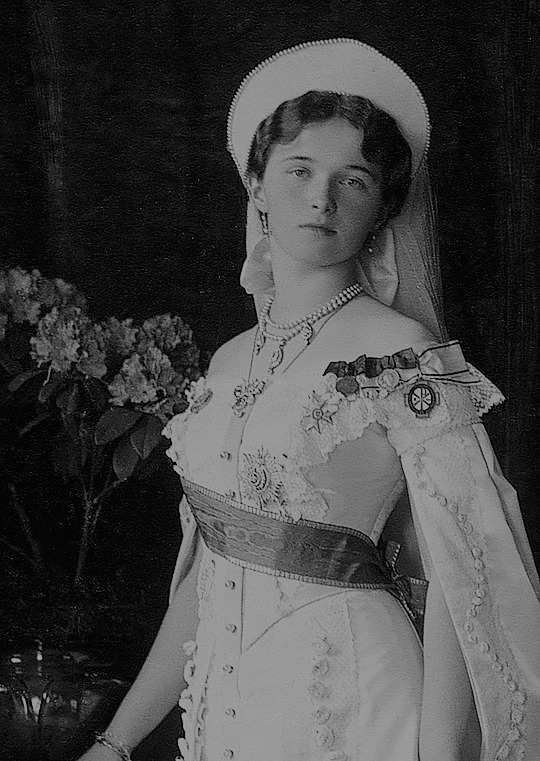

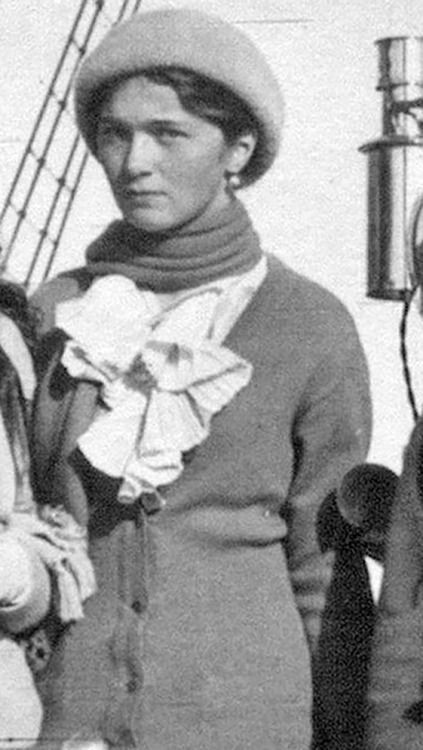
Grand Duchess Olga Nikolaevna of Russia (1895-1918).
Eldest daughter of Tsar Nicholas II of Russia.
.
From her earliest years she was known for her compassionate heart and desire to help others, but also for her temper, blunt honesty and moodiness. Olga loved to read and, unlike her four siblings, enjoyed school work. "She had good reasoning powers as well as initiative, a very independent manner, and a gift for swift and entertaining repartee." recalled her Swiss tutor, Pierre Gilliard. She enjoyed reading about politics and read newspapers. Olga also reportedly enjoyed choosing from her mother's book selection. But she sometimes showed herself willful and even disobedient.
.
She idolized her father and wore a necklace with an icon of St. Nicholas on her chest. Though she also loved Alexandra, her relationship with her mother was somewhat strained during her adolescence and early adulthood. Alexandra complained about Olga's grumpiness, bad humor and general reluctance. Olga could be spoiled, capricious, and lazy but her mother often reminded to be an example for the other children and to be patient with her younger sisters and with her nurses. She was also strongly patriotic, and could make comments against Germans which would hurt her mother, born in Germany.
.
Inspired by her religious upbringing, Olga took control of a portion of her sizable fortune when she was twenty and began to respond independently to requests for charity. A court official, Alexander Mossolov, recalled that Olga's character was "even, good, with an almost angelic kindness" by the time she was a young woman.
.
Olga was a chestnut-blonde with bright blue eyes, a broad face, a fresh complexion and a turned up nose. She was slightly above the medium height.
.
During her lifetime, Olga's future marriage was the subject of great speculation within Russia. Matches were rumored with Grand Duke Dmitri Pavlovich of Russia, Crown Prince Carol of Romania (whom she disliked), Edward, Prince of Wales, eldest son of Britain's George V, and with Crown Prince Alexander of Serbia. Olga herself wanted to marry a Russian and remain in her home country. During World War I, she nursed wounded soldiers in a military hospital until her own nerves gave out and, thereafter, oversaw administrative duties at the hospital. She was given arsenic injections in October 1915, at the time considered a treatment for depression or nervous disorders. During this time, she fell in love with Dmitri Chakh-Bagov, a wounded soldier she cared for when she was a Red Cross nurse.
.
According to the accounts of courtiers, Olga knew the financial and political state of the country during the war and revolution.
She was murdered with her family by the Bolsheviks.
[Submission]
#Grand Duchess Olga Nikolaevna#olga nikolaevna#olga romanov#Olga Romanova#early 20th century#20th century history#20th century#1900s#ww1#world war 1#world wars#russian history#russia#1910s#edwardian era#history#women's history#women history#women in history#herstory#history crush#historical crush#history hottie#historical hottie#history nerd#history geek#otma romanov#otma#naotmaa#romanov family
141 notes
·
View notes
Text
Special 300 followers post: places to visit while in Romania (1/5)
I know this post is long overdue, sorry for stalling posting this, but it was hard to think of just a couple of places to visit. Sadly, my mission to bring just a couple of places to visit failed, and I have 40 places to talk about in this post. So, with that said, in no particular order (beside an alphabetical one), here are 40 places to visit while in Romania:
1. Alba Iulia:
Alba Iulia, the seat of Alba county, has a historical significance for Romania. Since the Dacians lived there, the city was an important economical, political and social centre, known back then as Apulon. Once the Romans arrived, they renamed it Apulum and the XIII Gemina Legion was stationed there. Apulum is the largest Roman castrum on the current territory of Romania.
Alba Iulia has also a history of siege, military victories, and unions. The catholic cathedral still has canon marks from a siege by the Ottomans in 1442. In 1599, Michael the Brave entered victoriously the city after the battle of Șelimbăr, becoming Voievode of Transylvania (and soon after uniting Transylvania and Wallachia with Moldavia) and in 1918 the city was chosen for the declaration of union of Transylvania with the Kingdom of Romania, and 4 years later, King Ferdinand of Romania was symbolically crowned there as King of Romania. Each year, on the 1st of December, there are celebrations held in Alba Iulia, as in the rest of Romania, to celebrate the Great Union, but Alba Iulia remains the spiritual center of the event, and I wholeheartedly recomend visiting it in that period.




2. Sculptural Ensemble of Constantin Brâncuși at Târgu Jiu
The Sculptural Ensemble of Constantin Brâncuși at Târgu Jiu is an homage to the Romanian heroes of the First World War.
The ensemble comprises three sculptures: The Table of Silence (a circular stone table surrounded by twelve hourglass-seats, which symbolize time), The Gate of the Kiss (it features a kiss motif on the gate pillars; the transition to another life occuring through it) and the Endless Column (symbolizes the concept of infinity and the infinite sacrifice of the Romanian soldiers), on an axis 1,300 m (4,250 ft) long, oriented west to east. The ensemble is considered to be one of the great works of 20th-century outdoor sculpture.


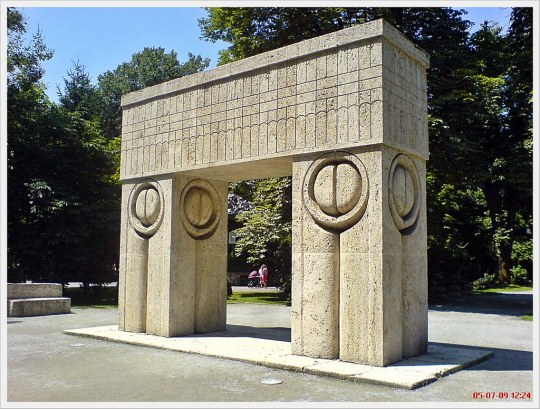

3. Black Church
Biserica Neagră or, as it would be translated, the Black Church, is a church build by the German community in Brașov, being the most important Lutheran place of worship in the region and Romania’s main gothic style monument. When it was finished, it was so big (89 meters/292 feet in length and 65 meters/213 feet in height) that it was declared the biggest church between Vienna and Constantinople.
When visiting, you may want to pay attention to schedule, since in summer time, there are pipe organ concertos three times a week, from musicians across both Romania and other places.


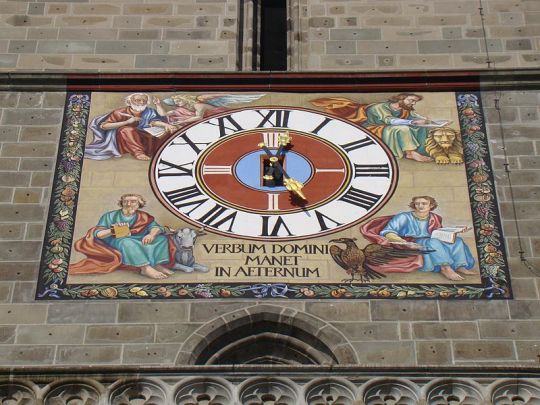

4. Bran Castle
Castelul Bran or Bran Castle (or, as much as I hate to say it, Dracula’s Castle) is a national monument and landmark in Romania. Bran Castle was built by the Transylvanian Saxons of Brașov as a defensive fortress against the Ottoman Empire, and now is a museum dedicated to displaying art and furniture collected by Queen Marie of Romania.
When visiting the Castle, beware the presence of Dracula, as the area is chocked by shops and tourist traps dedicated to the fanged count, but, sadly, this castle may be errenously known as the inspiration for Bram Stoker’s book, but there is evidence that he never visited the place, and the description does not match the actual castle. While you are there, please visit the ethnographic museum, which is close by, and take a breath of the authentic local culture, and not a breath of the stereotypical vampires. There is more to Bran than Dracula and vampires.


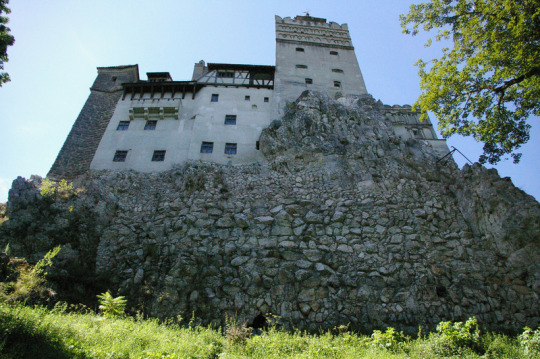
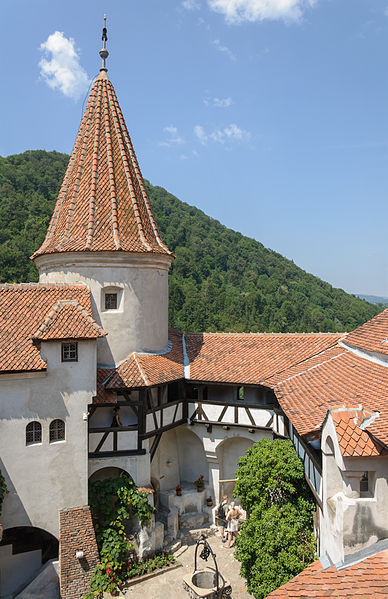
5. Cantacuzino Castle
Castelul Cantacuzino or Cantacuzino Castle is a building completed in 1911, at the request of Prince George Grigore Cantacuzino. The building has a Neo-Romanian style, and belonged to the noble Cantacuzino family, until 1948, when the building was forcefully nationalized and transformed into a preventorium.
The Castle is now a museum, but I have to say, it is sad to visit it. During communism, the building can be said to have been vandalised: the original wall decorations in some rooms were painted over, in some rooms it is 3 layers of paint, in one there are 6. The original furniture was removed, and the family emblem on doors was removed. Seeing and hearing about the damage made my heart ache when I visited it. After the Revolution, the building was given back to the descendants of the Cantacuzino family, who then decided to sell it to private investors. Today, it is open to the public, but, if I recall correctly, the descendants sometime come together at the castle, to have family reunions.
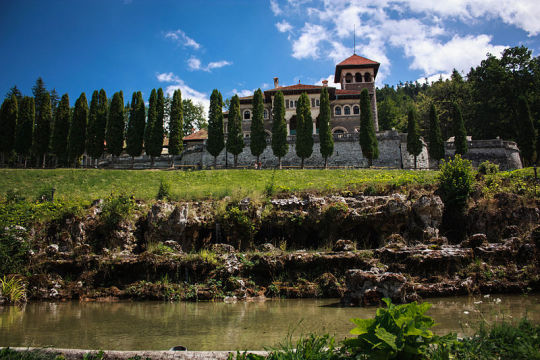

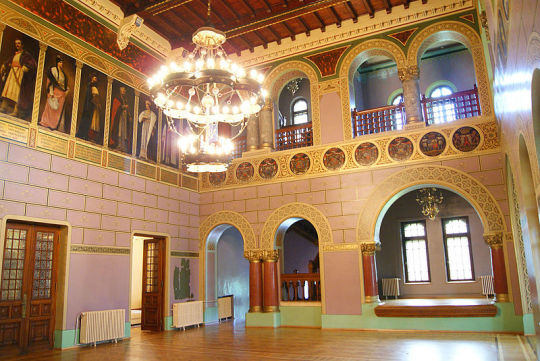
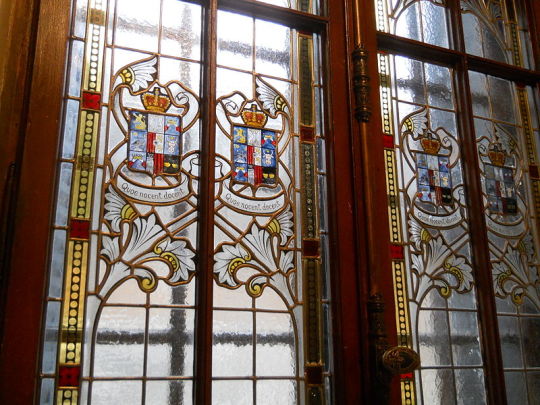
6. Hunyadi Castle
Castelul Huniazilor/Corvinilor or Corvin/Hunyadi Castle is a Gothic-Reneissance Castle in Hunedoara, being one of the largest castles in Europe.
Being known as one of the most beautiful castles in the world, its history began in the 15th century, but the castle is now standing because of a vigurous restoration campaign after a desastrous fire and years of total neglect. The Castle has been featured in different movies and TV shows, the most recent one being 2018′s The Nun, being named as “Cârța Monestary“ in the movie.
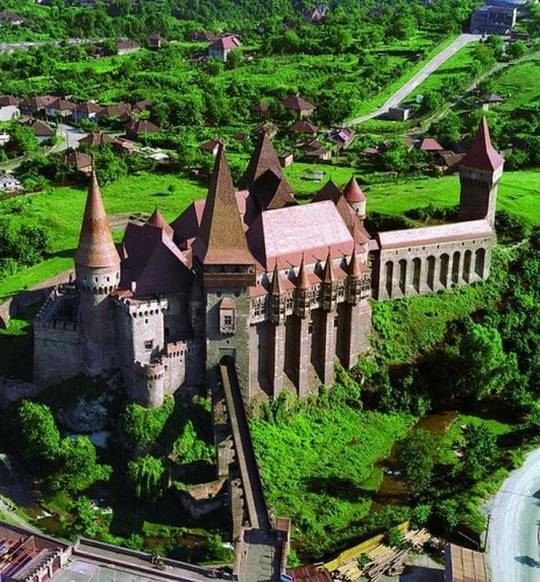



7. Peleș Castle
Castelul Peleș or Peleș Castle is a Neo-Renaissance castle and former royal summer residence located near Sinaia, constructed for King Carol I, the first King of Romania.
The Castle is placed in a beautiful sceneric zone, being able to somewhat transport you back in time to the monarchical era. Peleș, much like the Cantacuzino Castle, was nationalised after the forced abdication of King Mihai, but it has been preserved and returned to the royal family of Romania, which allows the museum inside to still function. Near the Castle, there is one more location I recommend visiting: the smaller Pelișor Castle, which was very dear to Queen Marie of Romania, so much so that her heart is kept in the room it stopped beating. Both castles are jewels of architecture among Romanian castles, and are a must when it comes to visiting Romania.
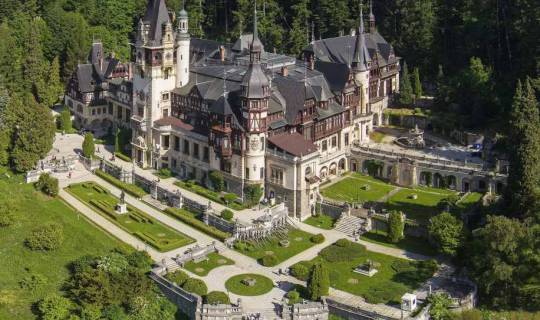


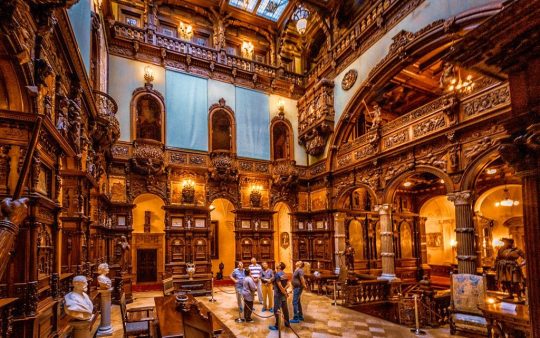
8. Cazanele Dunării
Cazanele Dunării is a sector of the Defileul Dunării region, the region where the Danube has carved out its path over centuries through the Carpathians. The area showcases beautifully the wonders of nature, conquest and ordinary life of cultures iving by the course of a river.
There are 4 hour cruises leaving the town of Orșova, on these cruises you can see the surrounding landscape, small monestaries and two important monuments, one ancient and one modern, but both tell the story of how the Romanian people formed by tradition: the ancient Tabula Traiana, a Roman plaque to celebrate the victorious conquest of Dacia by Emperor Trajan, and the modern carved head of Decebal, the last king of the Dacians, who fought Trajan, until he killed himself to avoid a shameful capture. If you wish to visit other places, the border with Serbia is very close (the Danube itself is the border), and the surrounding towns and villages are very ethnically diverse, giving a taste of Serbian, Romanian, even Czech and German culture.
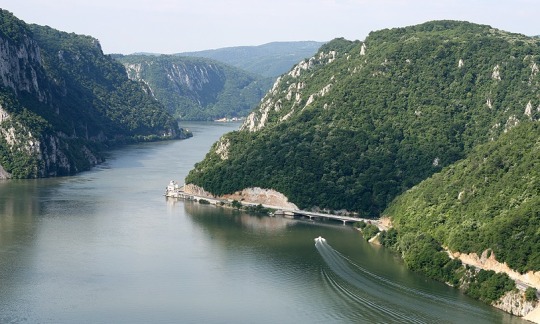



Part 2
#România#Romania#Transilvania#Transylvania#Muntenia#Banat#Oltenia#Alba Iulia#Masa Tăcerii#The Table of Silence#Poarta Sărutului#The Gate of the Kiss#Coloana Infinitului#Endless Column#Biserica Neagră#Black Church#Castelul Bran#Bran Castle#Castelul Cantacuzino#Cantacuzino Castle#Castelul Huniazilor#Hunyadi Castle#Castelul Peleș#Peleș Castle#Pelișor#Cazanele Dunării#Orșova#Tabula Traiana#Capul lui Decebal#Decebal's Head
177 notes
·
View notes
Photo
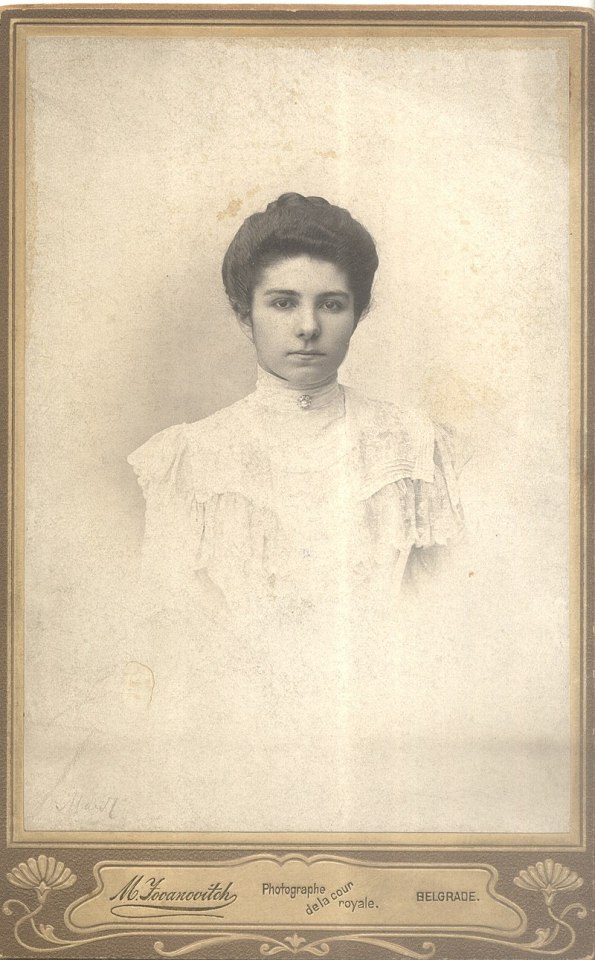
Princess Helen of Serbia and Yugoslavia (23 October 1884 – 16 October 1962) was a Serbian princess, the daughter of King Peter I of Yugoslavia and his wife Princess Zorka of Montenegro. She was the elder sister of George, Crown Prince of Serbia and King Alexander I of Yugoslavia. Helen was also a niece of Anastasia of Montenegro (or "Stana"), wife of Grand Duke Nicholas Nikolaevich of Russia, and of Milica of Montenegro, wife of Grand Duke Peter Nicolaievich of Russia, the women who introduced Grigori Rasputin to Tsarina Alexandra.
#Helen of Serbia and Yugoslavia#House Karađorđević#XIX century#XX century#people#portrait#photo#photography
3 notes
·
View notes
Text
Events 2.15
438 – Roman emperor Theodosius II publishes the law codex Codex Theodosianus.
590 – Khosrau II is crowned king of Persia.
706 – Byzantine emperor Justinian II has his predecessors Leontios and Tiberios III publicly executed in the Hippodrome of Constantinople.
1002 – At an assembly at Pavia of Lombard nobles, Arduin of Ivrea is restored to his domains and crowned King of Italy.
1113 – Pope Paschal II issues Pie Postulatio Voluntatis, recognizing the Order of Hospitallers.
1214 – During the Anglo-French War (1213–1214), an English invasion force led by John, King of England, lands at La Rochelle in France.
1493 – While on board the Niña, Christopher Columbus writes an open letter (widely distributed upon his return to Portugal) describing his discoveries and the unexpected items he came across in the New World.
1637 – Ferdinand III becomes Holy Roman Emperor.
1690 – Constantin Cantemir, Prince of Moldavia, and the Holy Roman Empire sign a secret treaty in Sibiu, stipulating that Moldavia would support the actions led by the House of Habsburg against the Ottoman Empire.
1764 – The city of St. Louis is established in Spanish Louisiana (now in Missouri, USA).
1798 – The Roman Republic is proclaimed after Louis-Alexandre Berthier, a general of Napoleon, had invaded the city of Rome five days earlier.
1835 – Serbia's Sretenje Constitution briefly comes into effect.
1862 – American Civil War: Confederates commanded by Brig. Gen. John B. Floyd attack General Ulysses S. Grant's Union forces besieging Fort Donelson in Tennessee. Unable to break the fort's encirclement, the Confederates surrender the following day.
1870 – Stevens Institute of Technology is founded in New Jersey, US, and offers the first Bachelor of Engineering degree in mechanical engineering.
1879 – Women's rights: US President Rutherford B. Hayes signs a bill allowing female attorneys to argue cases before the Supreme Court of the United States.
1898 – The battleship USS Maine explodes and sinks in Havana harbor in Cuba, killing about 274 of the ship's roughly 354 crew. The disaster pushes the United States to declare war on Spain.
1899 – Tsar Nicholas II of Russia issues a declaration known as the February Manifesto, which reduces the autonomy of the Grand Duchy of Finland, thus beginning the first period of oppression.
1909 – The Flores Theater fire in Acapulco, Mexico kills 250.
1923 – Greece becomes the last European country to adopt the Gregorian calendar.
1925 – The 1925 serum run to Nome: The second delivery of serum arrives in Nome, Alaska.
1933 – In Miami, Giuseppe Zangara attempts to assassinate US President-elect Franklin D. Roosevelt, but instead shoots Chicago mayor Anton J. Cermak, who dies of his wounds on March 6.
1942 – World War II: Fall of Singapore. Following an assault by Japanese forces, the British General Arthur Percival surrenders. About 80,000 Indian, United Kingdom and Australian soldiers become prisoners of war, the largest surrender of British-led military personnel in history.
1944 – World War II: The assault on Monte Cassino, Italy begins.
1944 – World War II: The Narva Offensive begins.
1945 – World War II: Third day of bombing in Dresden.
1946 – ENIAC, the first electronic general-purpose computer, is formally dedicated at the University of Pennsylvania in Philadelphia.
1949 – Gerald Lankester Harding and Roland de Vaux begin excavations at Cave 1 of the Qumran Caves, where they will eventually discover the first seven Dead Sea Scrolls.
1952 – King George VI of the United Kingdom is buried in St George's Chapel, Windsor Castle.
1954 – Canada and the United States agree to construct the Distant Early Warning Line, a system of radar stations in the far northern Arctic regions of Canada and Alaska.
1961 – Sabena Flight 548 crashes in Belgium, killing 73, including the entire United States figure skating team along with several of their coaches and family members.
1965 – A new red-and-white maple leaf design is adopted as the flag of Canada, replacing the old Canadian Red Ensign banner.
1971 – The decimalisation of the currencies of the United Kingdom and Ireland is completed on Decimal Day.
1972 – Sound recordings are granted U.S. federal copyright protection for the first time.
1972 – José María Velasco Ibarra, serving as President of Ecuador for the fifth time, is overthrown by the military for the fourth time.
1982 – The drilling rig Ocean Ranger sinks during a storm off the coast of Newfoundland, killing 84 workers.
1989 – Soviet–Afghan War: The Soviet Union officially announces that all of its troops have left Afghanistan.
1991 – The Visegrád Group, establishing cooperation to move toward free-market systems, is signed by the leaders of Czechoslovakia, Hungary and Poland.
1992 – Serial killer Jeffrey Dahmer is sentenced in Milwaukee to 15 terms of life in prison.
1992 – Air Transport International Flight 805 crashes in Swanton, Ohio, near Toledo Express Airport, killing all four people on board.
1996 – At the Xichang Satellite Launch Center in China, a Long March 3B rocket, carrying an Intelsat 708, veers off course and crashes into a rural village after liftoff, killing somewhere between six and 100 people.
1996 – The Embassy of the United States, Athens, is attacked by an antitank rocket, launched by the Revolutionary Organization 17 November.
2001 – The first draft of the complete human genome is published in Nature.
2003 – Protests against the Iraq war take place in over 600 cities worldwide. It is estimated that between eight million and 30 million people participate, making this the largest peace demonstration in history.
2010 – Two trains collide in the Halle train collision in Halle, Belgium, killing 19 and injuring 171 people.
2012 – Three hundred and sixty people die in a fire at a Honduran prison in the city of Comayagua.
2013 – A meteor explodes over Russia, injuring 1,500 people as a shock wave blows out windows and rocks buildings. This happens unexpectedly only hours before the expected closest ever approach of the larger and unrelated asteroid 2012 DA14.
2021 – Sixty people drown and hundreds are missing after a boat sinks on the Congo River near the village of Longola Ekoti, Mai-Ndombe Province, Democratic Republic of the Congo.
0 notes
Photo
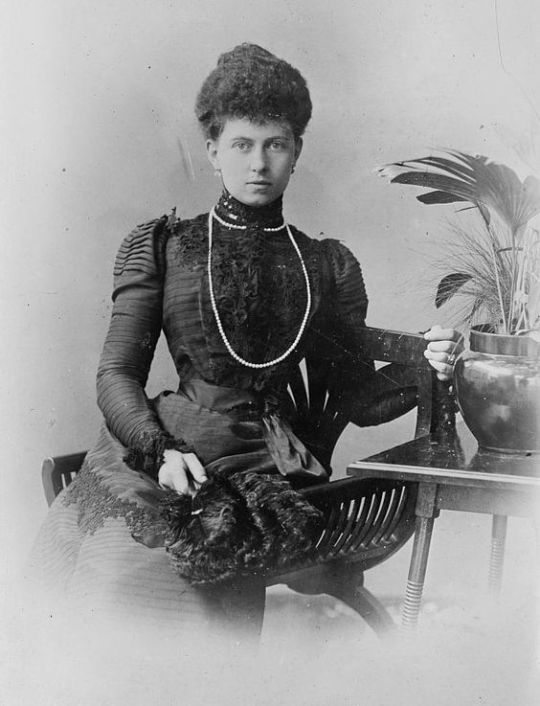
People that have married in to Royal Families since 1800
Greece
Sophia of Prussia born 14 June 1870 and died 13 January 1932
A granddaughter of Queen Victoria, Sophie Dorothea Ulrike Alice was born a Princess of Prussia at the Neues Palais in Potsdam, Prussia (Germany) on June 14, 1870. Sophie was the seventh of the eight children of Friedrich III, German Emperor and Victoria, Princess Royal (Vicky). Her mother was particularly close to her three youngest daughters and called them “my three sweet girls.” Sophie had four brothers and three sisters.
Sophie grew up at her parents’ two residences, Neues Palais in Potsdam and Kronprinzenpalais in Berlin. As her mother was English, Sophie was raised with a love of all things English and frequently visited her grandmother Queen Victoria. It was on one of these visits that Sophie became known to Crown Prince Constantine of Greece, known as Tino. During the summer of 1887, many European royals were in England to celebrate Queen Victoria’s Golden Jubilee.
Queen Victoria observed a relationship developing between her granddaughter Sophie and Constantine and was pleased. Constantine was not very bright, but as Queen Victoria wrote to Sophie’s mother, “a good heart and a good character…go far beyond cleverness.” The couple became engaged shortly after the death of Sophie’s father in 1888. Despite having the approval of Queen Victoria and her eldest brother Wilhelm, now the German Emperor, Sophie did not have the wholehearted agreement of her mother. Vicky dreaded sending Sophie so far away, and she thought the stability of the Greek throne was uncertain and the country underdeveloped.
Nevertheless, Sophie and Constantine married on October 27, 1889 in Athens, Greece. They had a Greek Orthodox service at the Metropolitan Cathedral of the Annunciation and then a Lutheran service in the private chapel of King George I of Greece. Constantine ‘s father had been Prince William of Denmark before he was elected King by the Greek National Assembly, and had retained his Lutheran faith.
Sophie and Constantine had six children and there was a 23 year age gap between their eldest and youngest child. The Greek, Romanian, Serbian, and Spanish Royal Families descend from their marriage. Sophie’s granddaughter via her son King Paul of Greece was named after her. Princess Sophia of Greece married King Juan Carlos of Spain and her name was changed to the more Spanish, Sofia. Her younger granddaughter via her son King Felipe VI of Spain is named Sofia.
In 1890, Sophie decided to convert to the Greek Orthodox faith. She was summoned by Augusta (known as Dona), the wife of her brother, Wilhelm II, German Emperor, who told Sophie that not only would Wilhelm find her conversion unacceptable, but she would be barred from Germany and her soul would end up in hell. Sophie replied that it was her business what she did. Augusta became hysterical and gave birth to a premature son, Prince Joachim. After the birth, Wilhelm, he wrote to his mother saying that if baby Joachim had died, Sophie would have murdered him. On the advice of her mother, Sophie ignored her brother, and gradually, the relationship between the siblings returned to normal.
While Crown Princess and later as Queen, Sophie cared intensely about healthcare, hygiene improvements, the school system, and the creation of employment opportunities for women through the promotion of arts and crafts. On March 18, 1913, Constantine’s father King George I was assassinated and Constantine acceded to the Greek throne as King Constantine I. At first, Constantine was a popular king because of his success in the war against Turkey and Bulgaria. At the outbreak of World War I in August 1914, Greece remained a neutral nation. However, Greece had signed a treaty with Serbia in 1913 obliging Greece to come to Serbia’s aid if attacked by Bulgaria. Bulgaria did attack Serbia, disagreements arose between King Constantine and the Greek Prime Minister, the King was accused of pro-German sentiments, and he was forced to abdicate in 1917.
Constantine, Sophie, and their family went into exile in Switzerland Crown Prince George, was also suspected of collaborating with the Germans, so it was the second son Alexander, who succeeded his father on the throne. In 1920, Alexander died of blood poisoning as a result of a monkey bite, and the third son Paul was asked to take over the throne. After Paul declined, Constantine was brought back after a change of government and a referendum allowing his return from exile.
Constantine was enthusiastically welcomed by the Greek people, but the enthusiasm did not last long. After a defeat in a war against Turkey in 1922, Constantine was forced to abdicate a second time and again go into exile. The crown went to his eldest son George, who reigned until 1925 when he was forced to abdicate. He was restored to the throne in 1936 and reigned until his death in 1947, when his younger brother Paul became king. Thus, all three sons of Sophie became Kings of Greece. Constantine died in 1923 in Palermo, Italy from a brain hemorrhage at the age of 54.
Sophie spent her last years at her villa in Florence, Italy. She died at the age of 61, on January 13, 1932 in Frankfurt am Main, Germany, where she had been undergoing treatment for cancer. Sophie was buried alongside her husband in the Greek Orthodox Church in Florence. In November of 1936, after the restoration of the monarchy, the remains of Sophie and Constantine were transferred to Greece and buried in the mausoleum at the Royal Cemetery at Tatoi Palace.
14 notes
·
View notes
Photo
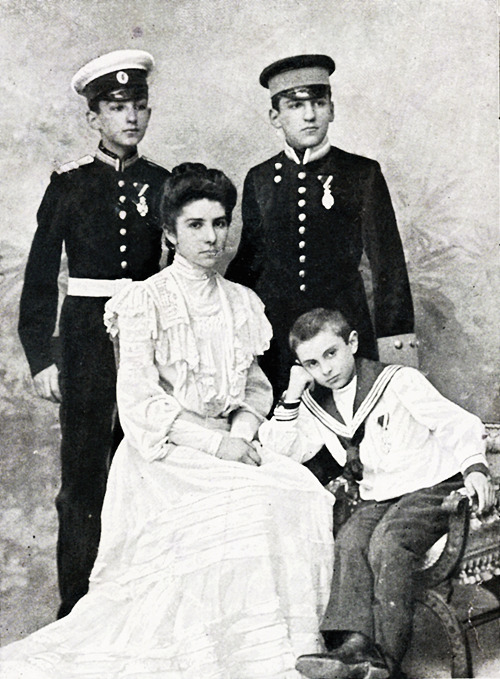
Princess Elena Petrovna with her brothers, George and Alexander, and cousin Paul.
Born Princess Helen (or Jelena) of Serbia, Elena Petrovna married Prince Ioann Konstantinovich of Russia. Her eldest brother, Crown Prince George, was compelled to give up his claim to the throne after a servant whom he had kicked in the stomach died, and so Alexander, the younger brother, eventually became king.
Paul, the boy in the sailor suit, was the son of Elena’s uncle Prince Arsen of Serbia and Princess Aurora Demidova, a Russian noblewoman. They divorced when Paul was very young and he was largely raised with his cousins. He later married Princess Olga of Greece and Denmark, the eldest daughter of Grand Duchess Elena Vladimirovna.
#romanov#elena petrovna#serbian royal family#yugoslavian royal family#paul of yugoslavia#helen of serbia
38 notes
·
View notes